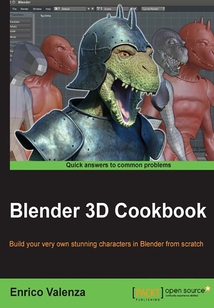舉報 

會員
Blender 3D Cookbook
最新章節:
Index
Thisbookisaimedattheprofessionalsthatalreadyhavegood3DCGIexperiencewithcommercialpackagesandhavenowdecidedtotrytheopensourceBlenderandwanttoexperimentwithsomethingmorecomplexthantheaveragetutorialsontheweb.However,it'salsoaimedattheintermediateBlenderuserswhosimplywanttogosomestepsfurther.It'stakenforgrantedthatyoualreadyknowhowtomoveinsidetheBlenderinterface,thatyoualreadyhave3Dmodelingknowledge,andalsothatofbasic3Dmodelingandrenderingconcepts,forexample,edge-loops,n-gons,orsamples.Inanycase,it'salsopossibleforakeenbeginnertofollowthisbook,bycombiningitwiththemanualontheBlenderWikiorprecedingitwithabasicBlenderUItutorialontheweb.Thekeyboard/mouseshortcutsfortheoperationsintherecipesare,atleastinallthemorerelevantcases,indicatedinbrackets.
目錄(104章)
倒序
- 封面
- 版權信息
- Credits
- About the Author
- About the Reviewers
- www.PacktPub.com
- Preface
- Chapter 1. Modeling the Character's Base Mesh
- Introduction
- Setting templates with the Images as Planes add-on
- Setting templates with the Image Empties method
- Setting templates with the Background Images tool
- Building the character's base mesh with the Skin modifier
- Chapter 2. Sculpting the Character's Base Mesh
- Introduction
- Using the Skin modifier's Armature option
- Editing the mesh
- Preparing the base mesh for sculpting
- Using the Multiresolution modifier and the Dynamic topology feature
- Sculpting the character's base mesh
- Chapter 3. Polygonal Modeling of the Character's Accessories
- Introduction
- Preparing the scene for polygonal modeling
- Modeling the eye
- Modeling the armor plates
- Using the Mesh to Curve technique to add details
- Chapter 4. Re-topology of the High Resolution Sculpted Character's Mesh
- Introduction
- Using the Grease Pencil tool to plan the edge-loops flow
- Using the Snap tool to re-topologize the mesh
- Using the Shrinkwrap modifier to re-topologize the mesh
- Using the LoopTools add-on to re-topologize the mesh
- Concluding the re-topologized mesh
- Chapter 5. Unwrapping the Low Resolution Mesh
- Introduction
- Preparing the low resolution mesh for unwrapping
- UV unwrapping the mesh
- Editing the UV islands
- Using the Smart UV Project tool
- Modifying the mesh and the UV islands
- Setting up additional UV layers
- Exporting the UV Map layout
- Chapter 6. Rigging the Low Resolution Mesh
- Introduction
- Building the character's Armature from scratch
- Perfecting the Armature to also function as a rig for the Armor
- Building the character's Armature through the Human Meta-Rig
- Building the animation controls and the Inverse Kinematic
- Generating the character's Armature by using the Rigify add-on
- Chapter 7. Skinning the Low Resolution Mesh
- Introduction
- Parenting the Armature and Mesh using the Automatic Weights tool
- Assigning Weight Groups by hand
- Editing Weight Groups using the Weight Paint tool
- Using the Mesh Deform modifier to skin the character
- Using the Laplacian Deform modifier and Hooks
- Chapter 8. Finalizing the Model
- Introduction
- Creating shape keys
- Assigning drivers to the shape keys
- Setting movement limit constraints
- Transferring the eyeball rotation to the eyelids
- Detailing the Armor by using the Curve from Mesh tool
- Chapter 9. Animating the Character
- Introduction
- Linking the character and making a proxy
- Creating a simple walk cycle for the character by assigning keys to the bones
- Tweaking the actions in Graph Editor
- Using the Non Linear Action Editor to mix different actions
- Chapter 10. Creating the Textures
- Introduction
- Making a tileable scales image in Blender Internal
- Preparing the model to use the UDIM UV tiles
- Baking the tileable scales texture into the UV tiles
- Painting to fix the seams and to modify the baked scales image maps
- Painting the color maps in Blender Internal
- Painting the color maps in Cycles
- Chapter 11. Refining the Textures
- Introduction
- Sculpting more details on the high resolution mesh
- Baking the normals of the sculpted mesh on the low resolution one
- The Armor textures
- Adding a dirty Vertex Colors layer and baking it to an image texture
- The Quick Edit tool
- Chapter 12. Creating the Materials in Cycles
- Introduction
- Building the reptile skin shaders in Cycles
- Making a node group of the skin shader to reuse it
- Building the eyes' shaders in Cycles
- Building the armor shaders in Cycles
- Chapter 13. Creating the Materials in Blender Internal
- Introduction
- Building the reptile skin shaders in Blender Internal
- Building the eyes' shaders in Blender Internal
- Building the armor shaders in Blender Internal
- Chapter 14. Lighting Rendering and a Little Bit of Compositing
- Introduction
- Setting the library and the 3D scene layout
- Setting image based lighting (IBL)
- Setting a three-point lighting rig in Blender Internal
- Rendering an OpenGL playblast of the animation
- Obtaining a noise-free and faster rendering in Cycles
- Compositing the render layers
- Index 更新時間:2021-07-16 13:26:05
推薦閱讀
- Getting Started with Citrix XenApp? 7.6
- 精通Nginx(第2版)
- 區塊鏈架構與實現:Cosmos詳解
- Python從菜鳥到高手(第2版)
- Learning Bayesian Models with R
- 基于Struts、Hibernate、Spring架構的Web應用開發
- Yii Project Blueprints
- iOS自動化測試實戰:基于Appium、Python與Pytest
- 計算機應用基礎教程(Windows 7+Office 2010)
- 運維前線:一線運維專家的運維方法、技巧與實踐
- Julia數據科學應用
- 大數據時代的企業升級之道(全3冊)
- 3ds Max 2018從入門到精通
- 嵌入式C編程實戰
- 啊哈C語言!:邏輯的挑戰(修訂版)
- Web前端開發技術實踐指導教程
- Learning Puppet
- 測試架構師修煉之道:從測試工程師到測試架構師(第2版)
- 一個APP的誕生:從零開始設計你的手機應用
- Java實例精通
- Python:Penetration Testing for Developers
- Java設計模式(第2版)
- Django 3 Web應用開發實戰
- Python極客項目編程(第2版)
- Building a Web Application with PHP and MariaDB:A Reference Guide
- Getting Started with ownCloud
- 亮劍Java項目開發案例導航
- Android App開發進階與項目實戰
- 云計算與數據中心自動化
- Arduino開發實戰指南:STM32篇

